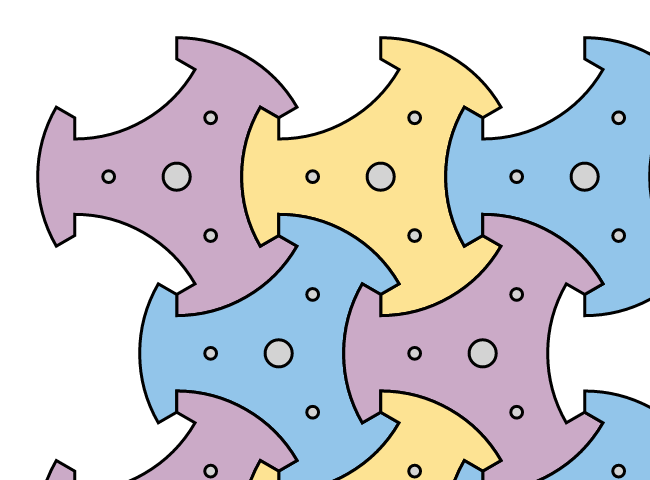It looks like you're using an Ad Blocker.
Please white-list or disable AboveTopSecret.com in your ad-blocking tool.
Thank you.
Some features of ATS will be disabled while you continue to use an ad-blocker.
share:
Now to consider the important issue of interlocking trispokedovetiles against movement in the direction normal to the tiled plane, which for the
application of tiled armour would be the normal to the armour surface, in the direction of a bullet's path.
BILAYER TRISPOKEDOVETILES
I propose that the unit armour tile be comprised of 2 joined trispokedovetiles with matching HEXAGON parameters but each with a different CIRCLE percentage.
For example, suppose we choose trispokedovetiles with CIRCLE = 100% and 121%.
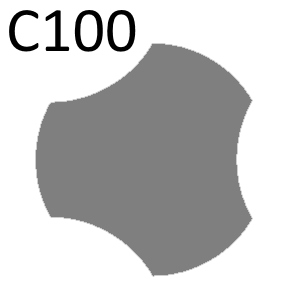
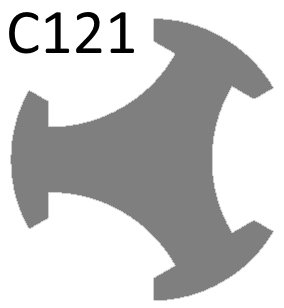
The reason for choosing C100 for the outer layer of the armour is because its 120 angle corners would be more robust.
The reason for choosing C121 for the inner layer of the armour is because CIRCLE = 121% offers the largest percentage where the neck attacking the outer part rings is at least twice the thickness of the ring, attempting to balance the robustness of the ring parts to the robustness of the neck versus tensile stresses.
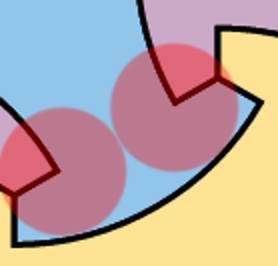
Stacking and joining those together forms a bilayer trispokedovetile, "C100+C121".
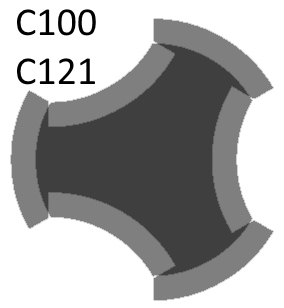
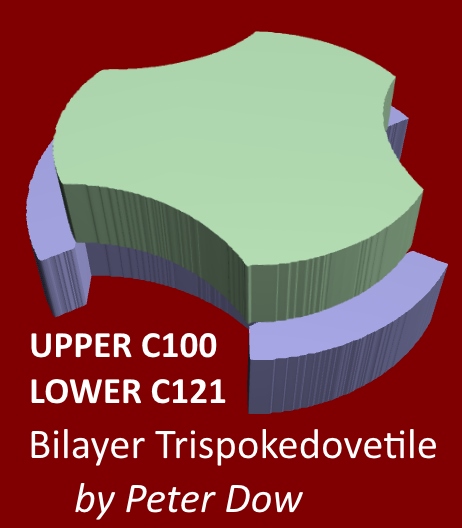
Drawing the 2 layers semi-transparently we can see how the bilayer trispokedovetiles would interlock in the normal to the plane.
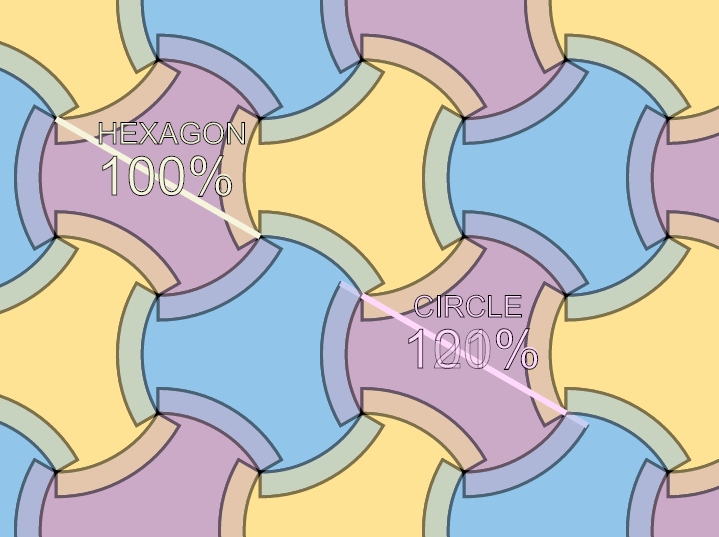
2/3rds of the tiles can be slotted together, either the yellows and the blues or the yellows and the purples or the blues and the purples.
However the final 1/3rd of the tiles would not simply slot in and would have be inserted by joining the two halves of the bilayer trispokedovetile in situ.
BILAYER TRISPOKEDOVETILES
I propose that the unit armour tile be comprised of 2 joined trispokedovetiles with matching HEXAGON parameters but each with a different CIRCLE percentage.
For example, suppose we choose trispokedovetiles with CIRCLE = 100% and 121%.


The reason for choosing C100 for the outer layer of the armour is because its 120 angle corners would be more robust.
The reason for choosing C121 for the inner layer of the armour is because CIRCLE = 121% offers the largest percentage where the neck attacking the outer part rings is at least twice the thickness of the ring, attempting to balance the robustness of the ring parts to the robustness of the neck versus tensile stresses.

Stacking and joining those together forms a bilayer trispokedovetile, "C100+C121".


Drawing the 2 layers semi-transparently we can see how the bilayer trispokedovetiles would interlock in the normal to the plane.

2/3rds of the tiles can be slotted together, either the yellows and the blues or the yellows and the purples or the blues and the purples.
However the final 1/3rd of the tiles would not simply slot in and would have be inserted by joining the two halves of the bilayer trispokedovetile in situ.
a reply to: Mr Peter Dow
I've been working on similar systems for a long time...
Can I get your permission to integrate some of your work with mine?
I've been working on similar systems for a long time...
Can I get your permission to integrate some of your work with mine?
originally posted by: roguetechie
a reply to: Mr Peter Dow
I've been working on similar systems for a long time...
Really? Can you show me, or is your work and systems only "top secret" and not quite ready for "Above Top Secret" prime-time?
originally posted by: roguetechie
a reply to: Mr Peter Dow
Can I get your permission to integrate some of your work with mine?
Well thanks for asking because others would perhaps "integrate" my original ideas, use my intellectual property, copy my work without acknowledging or respecting my undeniable copy-rights.
Yes, those who are careful to acknowledge my copyright by citing me as follows -
Trispokedovetiles: Three-spoke dovetailing tiles by Peter Dow
Links -
scot.gcehosting.com...
peter-dow.blogspot.co.uk...
- do indeed have my qualified permission to put my ideas to good use, with the qualification that I reserve my rights to claim authorship and ownership of my intellectual property and to receive in due course fair payment of a share of sale prices and profits of goods sold and services provided consequential to the permitted application of my original ideas.
If there's money to be made out of my ideas then I want my fair share. No-one should expect to get away with passing my original ideas off as their own because the truth will be found out in any legal action that was required.
Peter Dow, scientist and inventor of Trispokedovetiles

edit on DecThu, 01 Dec 2016 05:46:08 -0600 -06:00America/Chicago31America/ChicagoThu, 01 Dec 2016 05:46:08 -0600 Thu by Mr Peter Dow because:
(no reason given)
edit on DecThu, 01 Dec 2016 05:47:39 -0600 -06:00America/Chicago31America/ChicagoThu, 01 Dec 2016 05:47:39 -0600 Thu
by Mr Peter Dow because: (no reason given)
a reply to: Mr Peter Dow
I'm not quite ready to put my stuff out in public, and it'll be awhile before I can do much more than mess with it in design software and do some basic simulation stuff with it.
You can be assured that if anything comes of it positive or negative that I'll contact you first before putting stuff out in public domain.
For now though it'll just be some casual and informal small scale experimentation.
I'm not quite ready to put my stuff out in public, and it'll be awhile before I can do much more than mess with it in design software and do some basic simulation stuff with it.
You can be assured that if anything comes of it positive or negative that I'll contact you first before putting stuff out in public domain.
For now though it'll just be some casual and informal small scale experimentation.
originally posted by: roguetechie
a reply to: Mr Peter Dow
I'm not quite ready to put my stuff out in public, and it'll be awhile before I can do much more than mess with it in design software and do some basic simulation stuff with it.
You can be assured that if anything comes of it positive or negative that I'll contact you first before putting stuff out in public domain.
For now though it'll just be some casual and informal small scale experimentation.
OK. You may be interested in this ...
For Computer-Aided Manufacturing of trispokedovetiles, I'm publishing today my new Javascript web-page -
Trispokedovetiles: CNC code to cut tiles web-page G-code generator [LINK]
- which generates Computer Numerical Control (CNC) code which I've tested with CNC Simulator Pro [LINK] but not on a real CNC cutter as yet.
TRISPOKEDOVETILES ROUTER CUTTING
My trispokedovetile CAD-CAM webpage now offers an (X,Y,Z) option for router cutting using rotary tool paths between spaced out tiles -
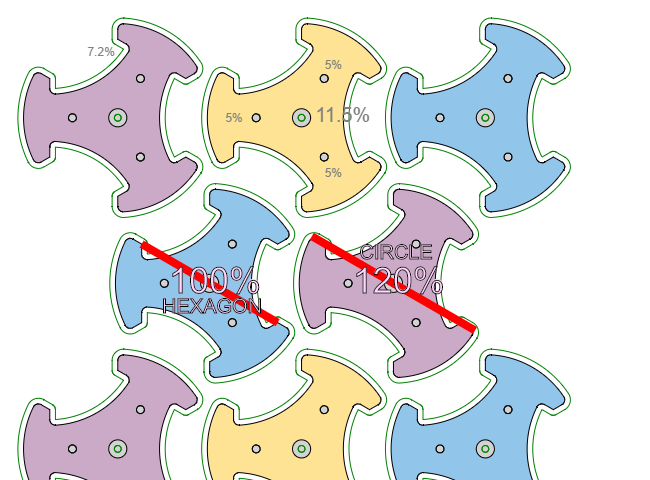
I've simulated the CNC router code -
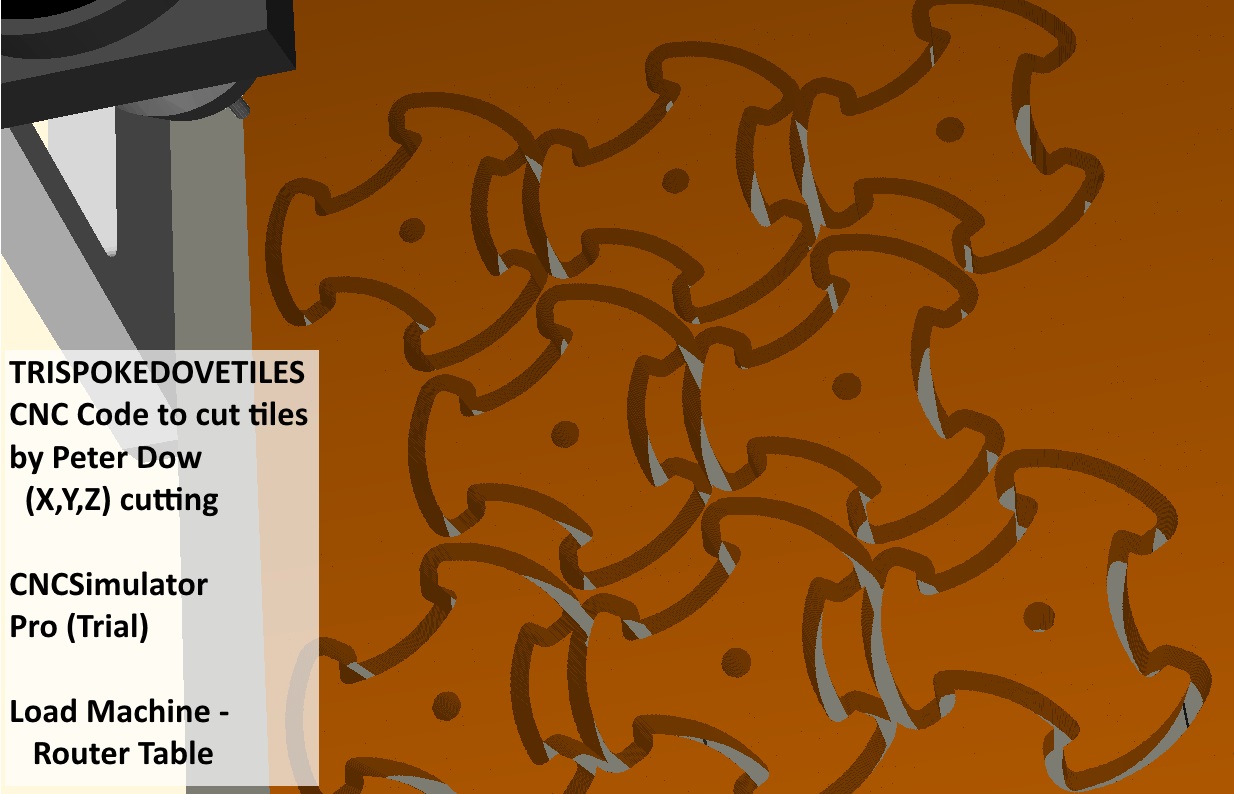
My trispokedovetile CAD-CAM webpage now offers an (X,Y,Z) option for router cutting using rotary tool paths between spaced out tiles -

I've simulated the CNC router code -

a reply to: Mr Peter Dow
When you make such a cutting template, take the pattern to the edge. You end up with many part pieces and these are great for edges.
If you don't, then one has to cut up whole ones and this is a waste.
Laser cutting is the way to go, depending on material.
P
When you make such a cutting template, take the pattern to the edge. You end up with many part pieces and these are great for edges.
If you don't, then one has to cut up whole ones and this is a waste.
Laser cutting is the way to go, depending on material.
P
Interesting. May still want to round out the sharp edges just a bit more, or at least the inward facing ones. If there's a spot that a stress fracture
or crack will start, that's likely going to be it. Narrow waists are another weak spot, so there may even be potential for even more revision.
Other than that, you could make some hexagonal capped on one end with a good bit of overhang. They'd still interlock underneath by tessellating as they do in your example, but the gaps between them wouldn't be exposed much with the capped pieces facing outwards. You could have 3 capped placed for every 4 that aren't. Shouldn't be too hard to picture.
Other than that, you could make some hexagonal capped on one end with a good bit of overhang. They'd still interlock underneath by tessellating as they do in your example, but the gaps between them wouldn't be exposed much with the capped pieces facing outwards. You could have 3 capped placed for every 4 that aren't. Shouldn't be too hard to picture.
a reply to: Mr Peter Dow
Suppose adding multiple layers of the stuff, somewhat offset from one another, may alleviate the problem of any gaps in the interlocking tiles.
Suppose adding multiple layers of the stuff, somewhat offset from one another, may alleviate the problem of any gaps in the interlocking tiles.

The above shows a variant I 3D modeled with some modifications in order to get rid of the sharp edges. I suppose it could be tightened up more if needed.
If you don't mind, I could also make a .STL file available for 3D-printing. Could link back to this thread or elsewhere to reference the source of the idea. Of course if you don't care for it, I'll leave it at that.
a reply to: Serdgiam
www.thingiverse.com...:2004137
That has the .STL file. There's also the .blend file, which has the setup for how I modeled it and some arrays to check the tessellation.
www.thingiverse.com...:2004137
That has the .STL file. There's also the .blend file, which has the setup for how I modeled it and some arrays to check the tessellation.
originally posted by: pauljs75
Interesting. May still want to round out the sharp edges just a bit more, or at least the inward facing ones. If there's a spot that a stress fracture or crack will start, that's likely going to be it.
originally posted by: pauljs75
The above shows a variant I 3D modeled with some modifications in order to get rid of the sharp edges. I suppose it could be tightened up more if needed.
Hey Paul thanks for your interest - most welcome and knock yourself out with whatever.
However, you might have saved yourself a lot of work if you had experimented a bit more with my CNC code generating page.
Trispokedovetiles: CNC code to cut tiles
scot.gcehosting.com...
Because you may have found out that I had developed a function to adjust the corner radius - simply adjust the "Corners" % input.
Corners = 50%
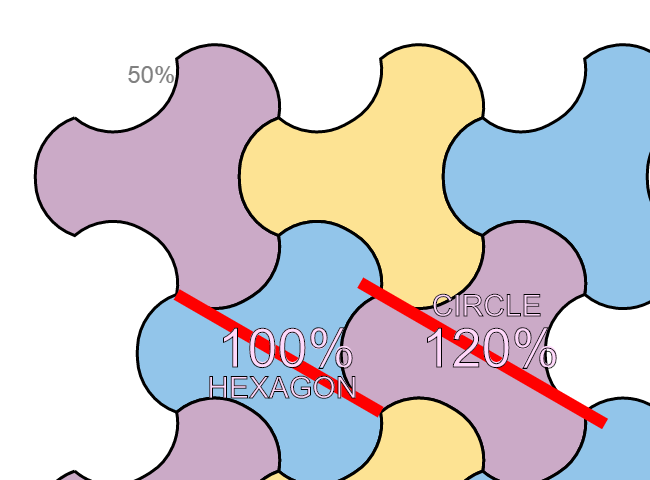
Corners = 30%
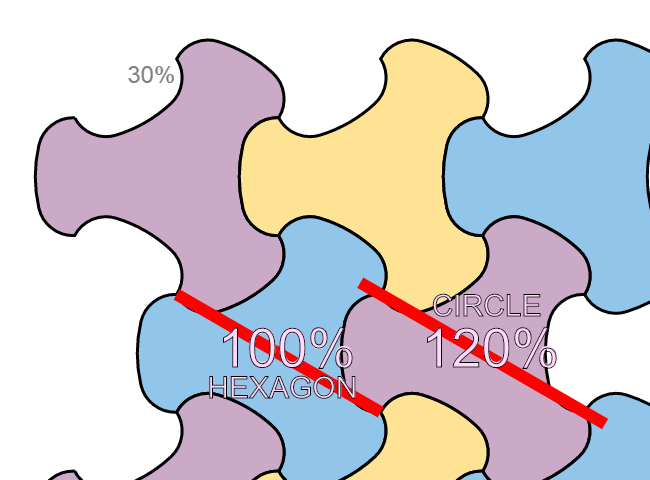
Corners = 16%
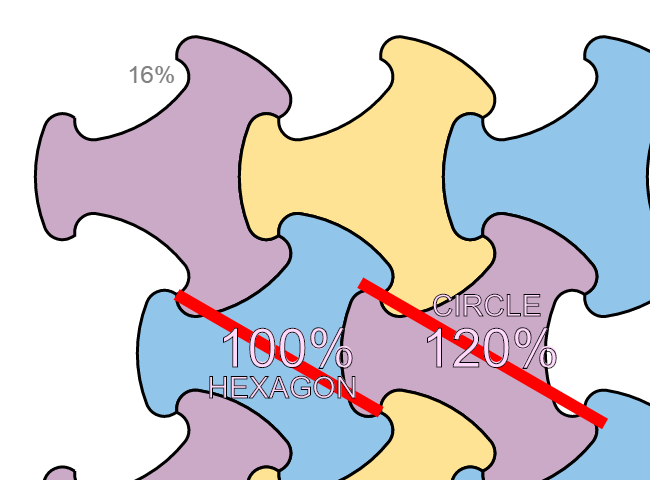
Corners = 8%
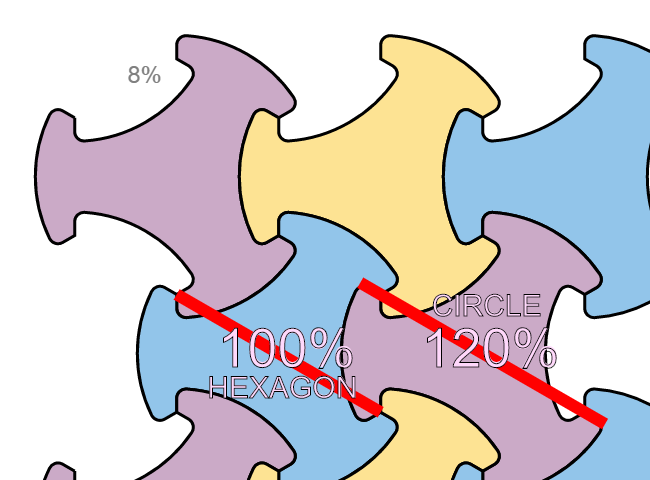
Corners = 4%
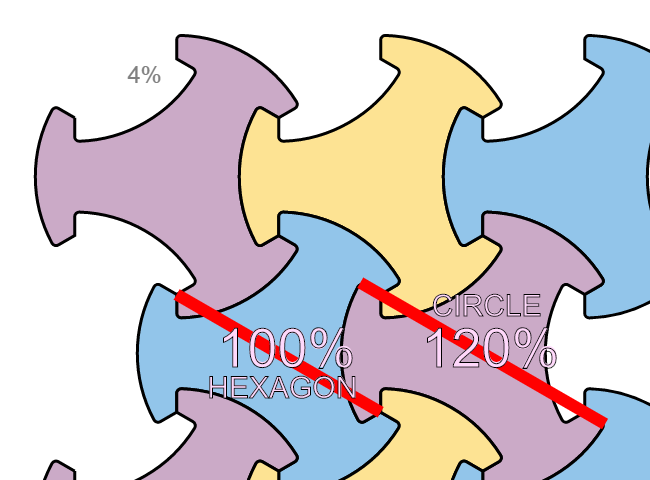
originally posted by: pauljs75
Other than that, you could make some hexagonal capped on one end with a good bit of overhang. They'd still interlock underneath by tessellating as they do in your example, but the gaps between them wouldn't be exposed much with the capped pieces facing outwards. You could have 3 capped placed for every 4 that aren't. Shouldn't be too hard to picture.
My "example"? What? My bilayer trispokedovetile example? From my earlier post?
originally posted by: Mr Peter Dow
Now to consider the important issue of interlocking trispokedovetiles against movement in the direction normal to the tiled plane, which for the application of tiled armour would be the normal to the armour surface, in the direction of a bullet's path.
BILAYER TRISPOKEDOVETILES
I propose that the unit armour tile be comprised of 2 joined trispokedovetiles with matching HEXAGON parameters but each with a different CIRCLE percentage.
For example, suppose we choose trispokedovetiles with CIRCLE = 100% and 121%.
The reason for choosing C100 for the outer layer of the armour is because its 120 angle corners would be more robust.
The reason for choosing C121 for the inner layer of the armour is because CIRCLE = 121% offers the largest percentage where the neck attacking the outer part rings is at least twice the thickness of the ring, attempting to balance the robustness of the ring parts to the robustness of the neck versus tensile stresses.
Stacking and joining those together forms a bilayer trispokedovetile, "C100+C121".
Drawing the 2 layers semi-transparently we can see how the bilayer trispokedovetiles would interlock in the normal to the plane.
2/3rds of the tiles can be slotted together, either the yellows and the blues or the yellows and the purples or the blues and the purples.
However the final 1/3rd of the tiles would not simply slot in and would have be inserted by joining the two halves of the bilayer trispokedovetile in situ.
That?
originally posted by: pauljs75
Other than that, you could make some hexagonal capped on one end with a good bit of overhang. They'd still interlock underneath by tessellating as they do in your example, but the gaps between them wouldn't be exposed much with the capped pieces facing outwards. You could have 3 capped placed for every 4 that aren't. Shouldn't be too hard to picture.
Well if you want to suggest an improvement then I suggest you create and post some images to explain your idea because a picture is worth a 1000 words.
originally posted by: andy06shake
a reply to: Mr Peter Dow
Suppose adding multiple layers of the stuff, somewhat offset from one another, may alleviate the problem of any gaps in the interlocking tiles.
You don't seem to have read my earlier post explaining my "bilayer trispokedovetiles" at all.
edit on JanSun, 08 Jan 2017 19:15:57 -0600
-06:00America/Chicago31America/ChicagoSun, 08 Jan 2017 19:15:57 -0600 Sun by Mr Peter Dow because: (no reason given)
originally posted by: pheonix358
a reply to: Mr Peter Dow
Laser cutting is the way to go, depending on material.
P
Some people kindly helped out and cut some example trispokedovetiles, and one person used a laser cutter.
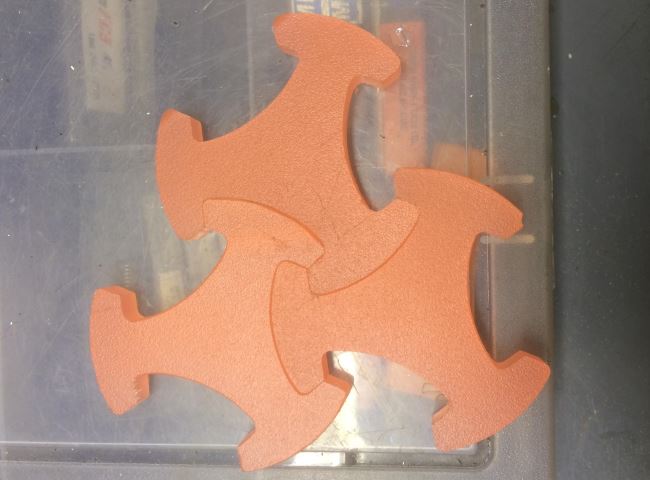
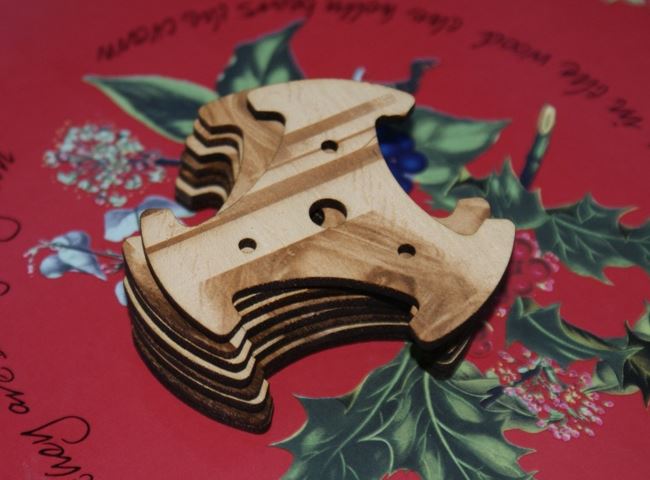
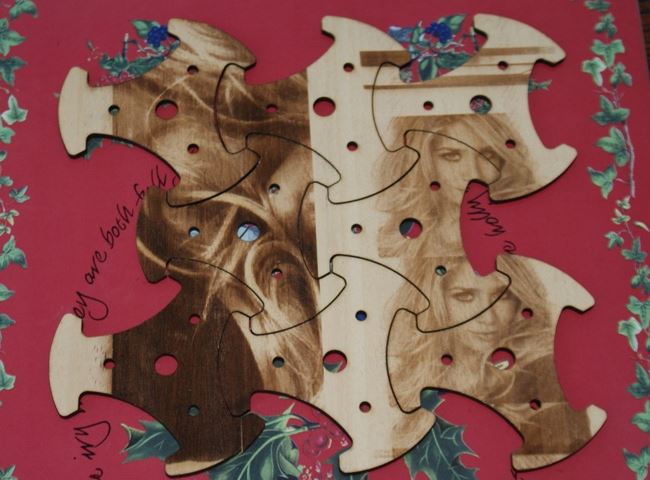
I've created a trispokedovetiles gallery webpage.
So if anyone CNC cuts some trispokedovetiles be sure to post images of your tiles here, or email them to me, and I'll include them in my gallery webpage.
Trispokedovetiles laser cut from metal using oxygen as an assist gas
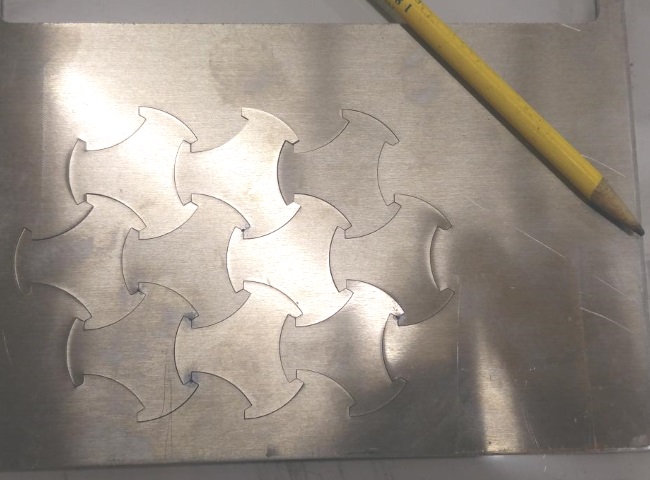
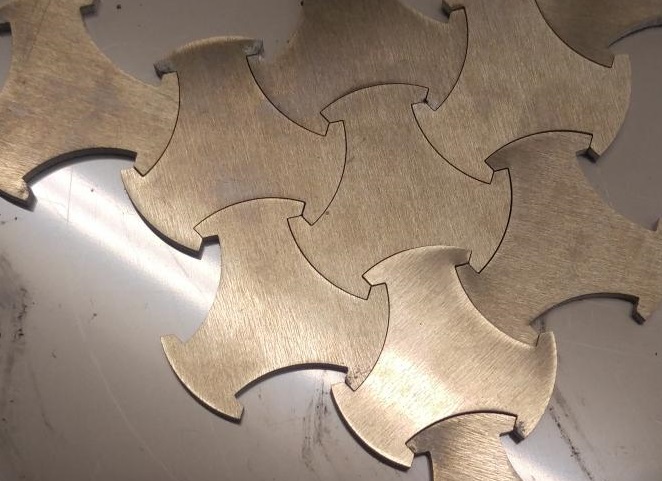
BEWARE BAD LINKS ABOVE!
I lost my website hosting in January. I was not "hacked" but the gcehosting administrator seems to have gone out of business and the hosting company he was using (godaddy) is serving various spurious adverts whenever anyone clicks one of my old links.
I have got the following pages back on-line with a different hosting company now so try these links.
LINKS -
I can't edit my earlier posts to correct the old links, sorry.
I've not done anything with this project since January.


BEWARE BAD LINKS ABOVE!
I lost my website hosting in January. I was not "hacked" but the gcehosting administrator seems to have gone out of business and the hosting company he was using (godaddy) is serving various spurious adverts whenever anyone clicks one of my old links.
I have got the following pages back on-line with a different hosting company now so try these links.
LINKS -
I can't edit my earlier posts to correct the old links, sorry.
I've not done anything with this project since January.
new topics
-
Orange County Makes Shoplifting a Felony
Other Current Events: 3 hours ago -
It's Offical Now
US Political Madness: 5 hours ago -
The reason it works is.....
General Chit Chat: 6 hours ago -
Dick Van Dyke saved from Wildfire by neighbours on his 99th birthday
People: 8 hours ago
top topics
-
It's Offical Now
US Political Madness: 5 hours ago, 9 flags -
Orange County Makes Shoplifting a Felony
Other Current Events: 3 hours ago, 9 flags -
The reason it works is.....
General Chit Chat: 6 hours ago, 6 flags -
Dick Van Dyke saved from Wildfire by neighbours on his 99th birthday
People: 8 hours ago, 3 flags
active topics
-
Christmas Dinner ??
Food and Cooking • 18 • : network dude -
Orange County Makes Shoplifting a Felony
Other Current Events • 13 • : mblahnikluver -
It's Offical Now
US Political Madness • 9 • : network dude -
-@TH3WH17ERABB17- -Q- ---TIME TO SHOW THE WORLD--- -Part- --44--
Dissecting Disinformation • 3810 • : 777Vader -
Post A Funny (T&C Friendly) Pic Part IV: The LOL awakens!
General Chit Chat • 7953 • : underpass61 -
Dick Van Dyke saved from Wildfire by neighbours on his 99th birthday
People • 1 • : soulrevival -
The reason it works is.....
General Chit Chat • 3 • : BeyondKnowledge3 -
London Christmas Market BANS Word ‘Christmas’
Social Issues and Civil Unrest • 44 • : Oldcarpy2 -
The Acronym Game .. Pt.4
General Chit Chat • 1024 • : JJproductions -
1 Billion dollars
General Entertainment • 12 • : Blueracer

